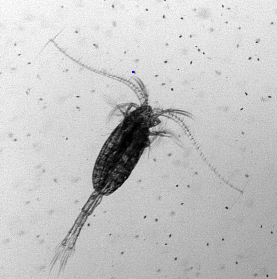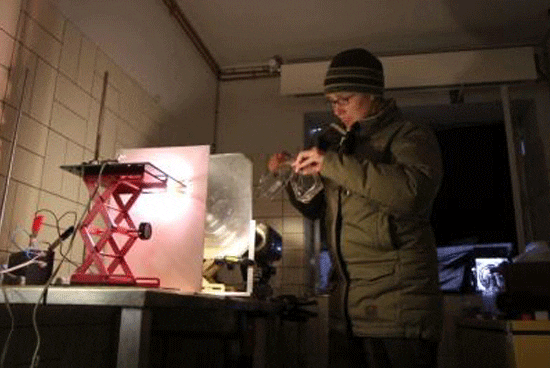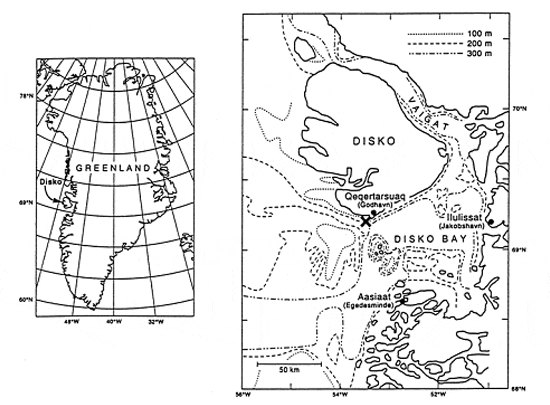It takes a lot for a nature lover to swap Disko Bay's picturesque panorama of icebergs and sea ice for the inside of a freezing cold laboratory with blinded windows with just a high speed video camera and a bottle of copepods for company.
Yet, this is exactly what PhD student Sanne Kjellerup from the National Institute of Aquatic Resources (DTU Aqua) in Denmark did most of April and May this year at the Arctic Station in Disko Bay, West Greenland. For the bottled copepods belonged to the hitherto more or less unknown species Metridia, freshly caught in the icy waters of Disko Bay.
Although biologists have been doing fieldwork in the area for decades, the copepod Metridia has up to now been completely overlooked. This is because this species during the daytime stays in water several hundred metres deep, and only comes to the surface layer in high abundance around midnight.

"When we were doing fieldwork in Godthbsfjorden last year, we discovered that there were a lot of Metridia in the water at night. Here at Arctic Station on Disko Island, we have never noticed Metridia before, so either we have missed them because we take most of our samples by day, or they have not been here before," says Sanne Kjellerup from DTU Aqua, who is doing a PhD on Metridia in collaboration with the Greenland Climate Research Centre in Nuuk.
This year, Sanne Kjellerup is looking specifically for Metridia, which she gently extracts from water samples. The water samples are brought to the Arctic Station every third day with the stations ship, Porsild, during DTU Aqua's fieldwork this spring.
"Our feeling is that Metridia could be a very important link in the food chain. In Nuuk Fjord, we found them in a fjord with a high abundance of cod fry. So maybe the cod larvae eat them - they do after all contain a lot of fat, says the PhD student.

Metridia is also a mystery in other ways. Unlike other copepods, it is active all winter, and does not go into hibernation.
"The other dominating copepods in Disko Bay, Calanus, which have been studied extensively, are only found in the summer and spring, where they feed on the large blooms of planktonic algae and unicellular zooplankton. In late summer, when they have stored fat, and the food sources disappear, they swim down to the sea bed where they hibernate all winter," says Sanne Kjellerup.
The question is how Metridia can survive with such a high level of activity in the 8-9 months when the amount of food is so small that other species have to go into hibernation to survive.
"To find out what Metridia eat, we investigate how it catches its food in the first place, and by association what size of particles it can eat. We do this by filming the copepods with high-speed video cameras. If copepods can catch both very small and very large types of food then they can exploit all available food sources in the water. For example, small unicellular algae, larger chain-forming algae and smaller zooplankton which might make it easier to survive," the researcher believes.
Preliminary studies suggest that one item that is clearly not on the menu is the large colony-forming algae, Phaeocystis, which have been very prevalent in the bay this spring:
"The copepods just swim around them," says Sanne Kjellerup on the basis of video footage from the Arctic Station.

The task of filming Metridia is now continuing in the laboratory at DTU Aqua. Using a camera, a laser and a powerful computer, Sanne and her supervisor, Professor Thomas Kirboe, can measure the water currents of the food-seeking copepod, and based on that calculate, for example, how the copepods get the food into their mouths, and how this affects the water around them during feeding. This is significant for establishing how easily the copepods themselves are found and eaten by, for example, fish larvae.
Some of Sanne Kjellerups colleagues are carrying out complementary studies, including DTU Aqua graduate student Magnus Bohr, who, by means of so-called "grazing experiments", is conducting some comparative studies, never before carried out, to find out, simultaneously, which planktonic algae the three known Calanus copepods as well as the enigmatic Metridia prefer to feed on.


